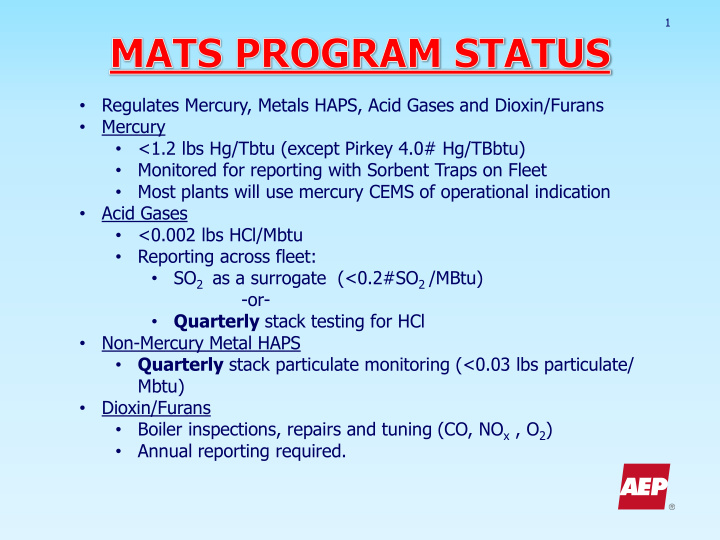



1 Regulates Mercury, Metals HAPS, Acid Gases and Dioxin/Furans • Mercury • <1.2 lbs Hg/Tbtu (except Pirkey 4.0# Hg/TBbtu) • Monitored for reporting with Sorbent Traps on Fleet • Most plants will use mercury CEMS of operational indication • Acid Gases • <0.002 lbs HCl/Mbtu • Reporting across fleet: • SO 2 as a surrogate (<0.2#SO 2 /MBtu) • -or- Quarterly stack testing for HCl • Non-Mercury Metal HAPS • Quarterly stack particulate monitoring (<0.03 lbs particulate/ • Mbtu) Dioxin/Furans • Boiler inspections, repairs and tuning (CO, NO x , O 2 ) • Annual reporting required. •
2 MERCURY ACID GASES Non-Hg Metals SCR & WFGD WFGD ESP – WFGD ACI* & Fabric Filter SBC** & Fabric Filter Fabric Filter DFGS & FF ACI & NID NID NID ACI & ESP SBC & ESP ESP ACI & CaBr2 & ESP WFGD ESP - WFGD WFGD & GMCS WFGD ESP - WFGD * ACI – activated carbons are typically a halogenated variety. ** SBC – Sodium bicarbonate – dry injected into fluework.
3 Numerous options to comply – very specific based upon plant. Utilization of existing equipment. Combustion process and acceptable fuel options. Unit designed are specific to a specific type/range of coal. Halogens in fuel --- Hg oxidation, corrosion, competing FGD reactions. Economic Drivers Cost benefit - - capital to costly = retire units Cost avoidance – maintain ESP for ash sales/avoid landfill expansion. Holistic Process View (Total Evaluated Cost) Sodium salts get to landfill and into landfill leachate. Flyash collection in WFGD, contributes to increase arsenic in absorbers. SCR ammonia slip affect on WFGD’s Hg removal. ESP performance with additional particulate (AC, trona, SBC). Equipment arrangement and space. Utilize as much of existing equipment (ductwork, stack) in retrofits. More remote areas increase capital and operating costs. Schedule Compliance date. May limit options.
Scale
Trona, Br-AC, Absorber SBC Boiler Stack ESP Dewatering FGD WWT LANDFILL LEACHATE POND Plant Pond Complex
Recommend
More recommend